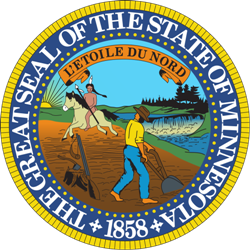Minnesotans Make History in 2018 US House Elections
The 2018 cycle is the first time since statehood in which two political parties each flipped more than one congressional seat

That feat had previously occurred only five times in Gopher State history.
In 1890, Democrats picked up three seats (William Harries beat Mark Dunnell in the 1st, Osee Hall defeated Darwin Hall in the 3rd, and James Castle knocked off Samuel Snider in the 4th) while the Populists gained one (Kittel Halvorson beat Solomon Comstock in the 5th).
In 1914, Republican Franklin Ellsworth flipped the open 2nd CD seat and Democrat Carl Van Dyke unseated GOPer Frederick Stevens in the 4th. [Note: In 1914, the state’s lone-at large seat from the 1912 election, held by Republican James Manahan, was eliminated and a 10th CD was created, won by Progressive Thomas Schall].
In 1946, the DFL flipped one seat (John Blatnik beat William Pittenger in the 8th) and the GOP flipped two (George MacKinnon won the open 3rd following the death of freshman William Gallagher and Edward Devitt unseated Frank Starkey in the 4th).
In 1992, DFLer David Minge flipped the open 2nd and Republican Rod Grams knocked Gerry Sikorski out of the 6th district.
In 1994, Republican Gil Gutknecht flipped the open 1st while DFLer Bill Luther did so in the open 6th.
But the 2018 cycle was particularly unique because it marked the first time in Minnesota that both parties flipped multiple seats. Democratic nominees Angie Craig and Dean Phillips unseated Jason Lewis and Erik Paulsen in the 2nd and 3rd CDs respectively and Republican nominees Jim Hagedorn and Pete Stauber picked off the open 1st and 8th CDs.
As a result, the state’s partisan delegation remains five DFLers and three Republicans for the fourth consecutive congress.
More than 295,000 Minnesotans voted for DFL U.S. House nominees (1,420,653) compared to their Republican counterparts (1,125,537), winning 55.4 percent of the congressional vote.
That’s a larger percentage than the vote received by five of the six DFL nominees for statewide office: the gubernatorial ticket of Tim Walz and Peggy Flanagan (53.8 percent), Senator Tina Smith (53.0 percent), Secretary of State Steve Simon (52.3 percent), state auditor –elect Julie Blaha (49.4 percent), and attorney general-elect Keith Ellison (49.0 percent). [However, these statewide races did feature more third party candidacies].
Only popular Senator Amy Klobuchar enjoyed greater support (60.3 percent).
The 2018 cycle was also just the second time over the last century in which Republicans flipped a U.S. House seat in Minnesota while Democrats netted 20+ seats nationally.
Out of the 12 previous cycles, only two-term DFLer Coya Knutson was defeated during these Democratic waves, losing her 9th CD seat to state Representative Odin Langen.
Follow Smart Politics on Twitter.
